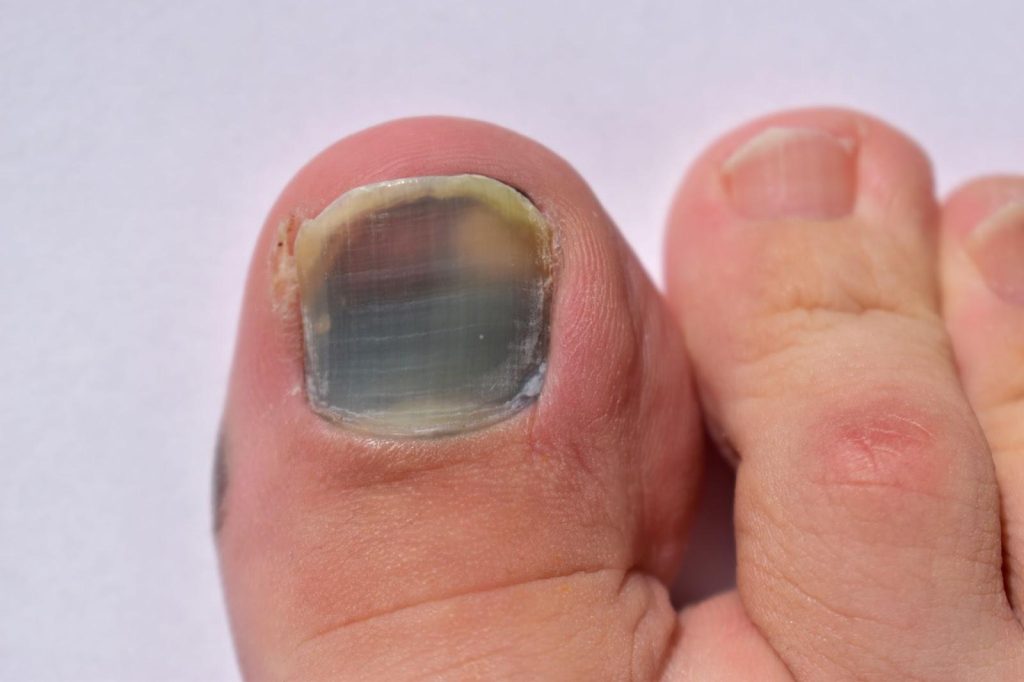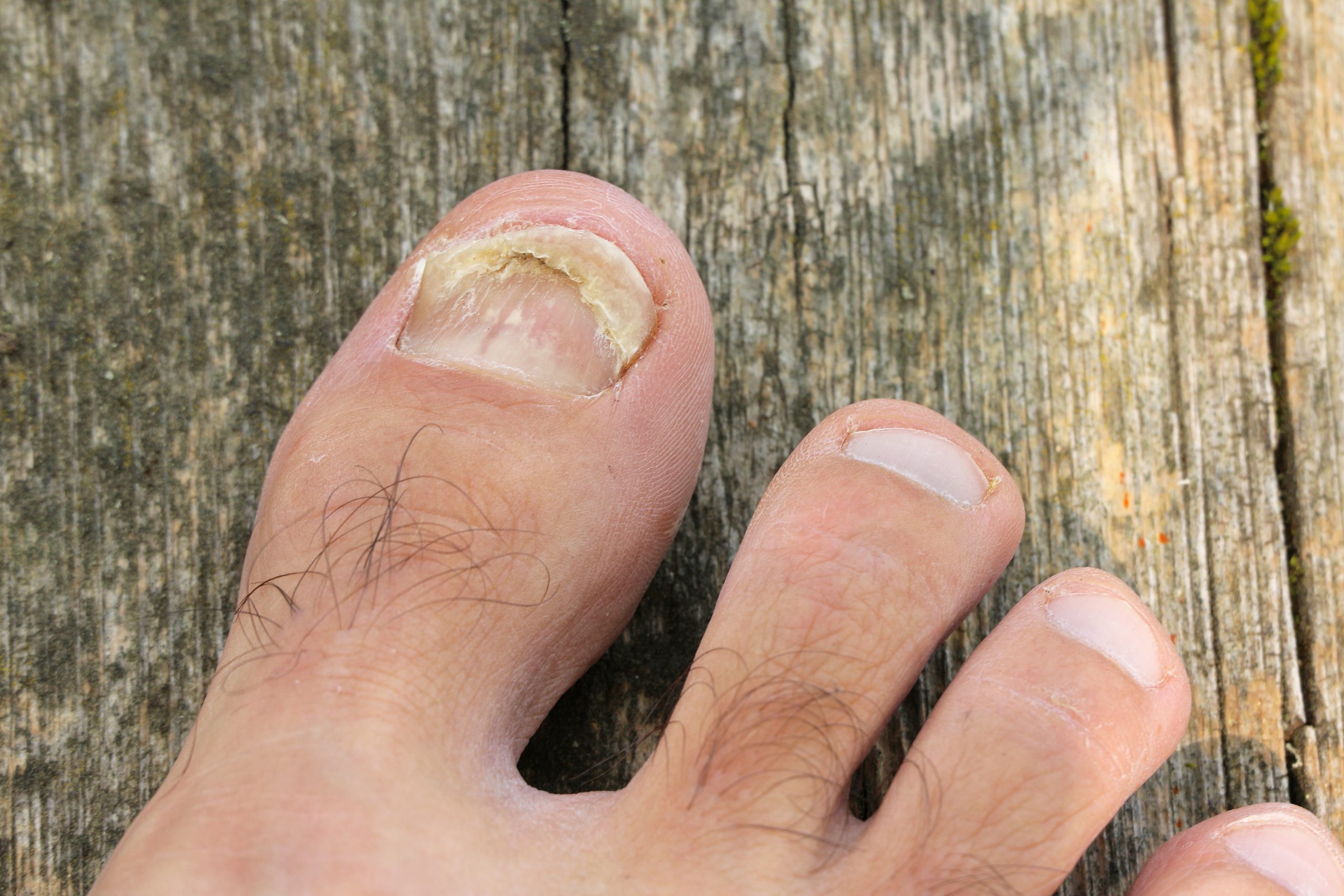What are the common causes of damaged toenails?
Toenail damage can result from several factors, including:
- Physical trauma: Injuries such as stubbing the toe, dropping a heavy object, or prolonged pressure from tight footwear can cause bruising, thickening, or separation of the nail as it grows.
- Fungal infection: Common in warm, moist environments, a fungal nail infection weakens the nail plate, leading to discolouration, brittleness, and crumbling.
- Medical conditions: Certain medical conditions such as psoriasis, diabetes, or poor circulation can affect nail health, altering its appearance, texture, and strength.
- Chemical exposure: Frequent contact with harsh cleaning agents or nail products can damage and erode the nail plate over time.
Identifying the underlying cause helps ensure the right treatment and prevents long-term damage.

What are the signs and symptoms of damaged toenails?
Toenail damage can affect both the appearance and comfort of your nails. The symptoms can vary depending on the cause (e.g. trauma, infection, or an underlying condition). Common signs include:
- Discolouration of the nail (white, yellow, brown, or black)
- Thickened or brittle nail texture
- Crumbling or splitting of the nail surface
- Nail lifting or separating from the nail bed
- Pain, tenderness, or swelling around the nail
- Redness or oozing
- Foul odour from the affected toe
- Distorted or slow nail growth
- Complete loss of the nail in severe cases
Complications of damaged toenails
If left untreated, damaged toenails can lead to several complications that affect nail health and comfort. These issues may also increase the risk of infection or long-term nail deformity. Common complications include:
- Secondary fungal or bacterial infections in and around the nail
- Persistent pain or inflammation in the affected toe
- Nail thickening or permanent deformity due to matrix injury
- Detachment of the nail from the nail bed (onycholysis)
- Recurrent ingrown toenails during regrowth
- Difficulty wearing shoes or walking comfortably
- Chronic nail discolouration or incomplete nail regrowth
Who is more likely to develop damaged toenails?
Certain habits, health conditions and environments can increase the likelihood of toenail damage. Recognising these risk factors can help prevent recurring nail problems. Common risk factors include:
- Wearing tight, ill-fitting or closed shoes for long periods
- Participating in high-impact sports such as football or basketball
- Repeated toenail trauma or stubbing injuries
- Living in hot and humid climates that encourage fungal growth
- Poor foot hygiene or infrequent nail trimming
- Underlying conditions like diabetes or poor circulation
- Smoking, which reduces blood flow and slows healing
- Weakened immunity from illness or certain medications
How are damaged toenails diagnosed?
Podiatrists usually diagnose a damaged toenail through a combination of clinical examination and simple tests to find the underlying cause. Common diagnostic steps include:
- Physical examination — the podiatrist assesses the nail’s colour, texture and attachment to check for trauma or infection.
- Injury and footwear history — questions are asked about recent injuries, shoe habits, or repetitive pressure on the toes.
- Fungal culture or nail scraping — the podiatrist may refer patients to do nail sample testing (e.g. microscopy or culture) to identify the presence of fungi.
- Circulation or nerve assessment — recommended for patients with poor blood flow, slow healing, or nerve-related issues.
What are the treatment options for damaged toenails?
Treatment depends on the underlying cause and how severely the nail or nail bed is affected. Common treatment approaches include:
- Trimming and nail care — gently trimming rough or loose edges helps prevent further tearing and reduces discomfort.
- Laser therapy — prescribed when nail damage is caused by fungal infection, targeting both the nail and surrounding skin.
- Protective footwear advice — wearing shoes with a wide toe box prevents additional pressure and allows healing.
- Debridement — removal of thickened or dead nail tissue to promote regrowth and reduce pain.
- Nail removal — partial or complete removal may be needed in severe or recurrent cases, allowing a healthy nail to regrow.
- Addressing underlying conditions — managing issues like diabetes or poor circulation supports healing and reduces recurrence
How to protect your toenails from damage?
Simple habits can greatly reduce the risk of toenail problems:
- Wear well-fitted, breathable shoes to reduce pressure.
- Keep feet clean and dry to prevent fungal growth.
- Keep nails neatly trimmed at all times.
- Use protective footwear during sports or heavy work.
- Avoid harsh chemicals or excessive nail treatments.
- Manage chronic conditions such as diabetes or vascular disease.
When to seek treatment for damaged toenails
See a podiatrist if you notice:
- Persistent pain, swelling or discolouration in your toes
- Toe redness, warmth or discharge suggesting infection
- Nail detachment or slow, distorted regrowth
- Recurrent nail thickening or cracking despite home care
Prompt evaluation helps prevent chronic pain, infection and permanent nail deformity.
Summary
Damaged toenails can occur for many reasons, from repeated trauma due to tight shoes or sports injuries to fungal infections or underlying medical conditions such as diabetes and psoriasis. A damaged toenail may appear thick, discoloured, brittle, lifted or even detached from the nail bed. While minor injuries often heal on their own, persistent pain, swelling or nail deformity can signal deeper nail bed or matrix damage. If left untreated, this can lead to infection, chronic inflammation or permanent nail loss.
Diagnosis usually involves physical examination and possible nail sampling for fungal culture to identify the underlying cause. Treatment options range from conservative trimming and antifungal treatments to nail debridement or removal in more severe cases. Preventive care, including proper footwear, foot hygiene, and management of underlying conditions, plays a key role in maintaining healthy nails and preventing recurrence.
If you are experiencing ongoing pain, thickening or discolouration of the toenail, schedule a consultation with Atlas Podiatry for a professional assessment and effective treatment to restore healthy nail growth and prevent long-term complications.
